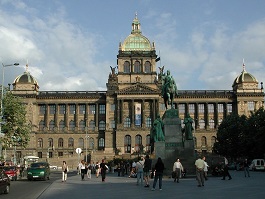
The reconstruction of the National Museum has been talked about since the 1990s
 |
- The neo-Renaissance building at the upper end of Wenceslas Square, designed by Josef Schulz and opened in May 1891, was the only similarly significant object in Prague that had never undergone renovation. Over more than a century, the building had to deal not only with emissions that discolored its once-light facade to gray but also with the consequences of subway construction, heavy traffic, or the damage left by an aerial bomb in May 1945 or bullets from occupying soldiers in August 1968.
- It has been discussed since the mid-1990s that the National Museum urgently needed renovation, when the then-director of the museum, Milan Stloukal, alerted the public and politicians about the catastrophic state of the building. However, the situation began to change only after his successor, the current head of the museum Michal Lukeš, took office in 2002. In the spring of 2006, members of parliament and the government agreed to release funds from the National Property Fund for reconstruction, and preparations could finally begin.
- However, before builders could enter the building, millions of collection items had to be evacuated; the relocation and other preparatory work took five years, with the last visitors visiting the museum in July 2011. Three of the exhibits, however, had to remain in place - the four-ton skeleton of a sperm whale, a giraffe, and an elephant from the zoo exhibit. The popular "whale" skeleton could have disintegrated during the move, and the other two animals are larger than the doors and would also risk destruction during disassembly.
- In August 2012, the museum began preparing a tender for the reconstruction contractor, with the preparation of the tender involving both the Ministry of Culture and subsequently the government, lasting three quarters of a year. Only in May 2013 could the museum announce an open tender for repairs, which were estimated to cost three billion crowns including VAT. Seven firms applied for the contract, and the winning bid came from the Consortium M-P-I National Museum (Metrostav, Průmstav, and IMOS Brno) with a price of approximately 1.6 billion including VAT.
- The announcement of the tender winner and later the signing of the contract with the winning consortium was delayed several times by decisions from the Office for the Protection of Competition, to which some unsuccessful bidders appealed. However, the appeals were gradually withdrawn, and in April 2014, the National Museum could finalize the contract. Reconstruction began after the builders officially took over the building on April 20, 2014, about a year later than originally planned. It was supposed to be completed by mid-October 2018, but without exhibitions.
- The preparation of the new exhibition concept fell behind after the antimonopoly office canceled the architectural competition in 2017. The creators of the new exhibitions were ultimately chosen by the management of the National Museum in a competitive dialogue with teams that had already participated in the canceled tender. The natural history exhibits will return to the right part of the museum, while historical exhibits will move into the left part. They will also extend into the new museum building, the former Federal Assembly, where the history of the 20th century will be displayed.
- The building of the former federal parliament was taken over by the National Museum in June 2009 after Radio Free Europe/Radio Liberty (RFE/RL) moved out. During the reconstruction of its historical headquarters, which connected the two buildings with a tunnel, the museum organized temporary exhibitions, and in the spring of 2015, it opened an interactive natural history exhibit, Noah's Ark, in the former Federal Assembly, which featured a large portion of animal exhibits previously displayed in the historical building.
- The most dramatic event of the National Museum's reconstruction was a fire that broke out on its roof in February 2016. The fire, which reminded many of the devastating fire of the Industrial Palace in October 2008, was managed to be extinguished quickly. However, the manner in which the traces of Soviet bullets from August 1968 were repaired drew criticism from some experts and laypeople. While previously, the light repaired parts were clearly visible against the dark facade, now they are practically indistinguishable on the cleaned surface.
The English translation is powered by AI tool. Switch to Czech to view the original text source.
Related articles
0
15.10.2019 | On November 17, a tunnel will open between the two NM buildings
0
02.11.2018 | Corrected National Museum will receive a new orientation system
0
26.10.2018 | After reconstruction for 1.8 billion CZK, the National Museum will partially reopen on Sunday
0
24.10.2018 | The National Museum celebrates its 150th anniversary with the reconstruction of the main building
0
14.09.2018 | In front of the National Museum will be the once-planned Palach Monument
0
19.07.2018 | The National Museum will open eight permanent exhibitions in 2019 and 2020
0
18.05.2018 | People will see the work of restorers and new spaces in the renovated museum
0
24.01.2017 | The entire National Museum will be accessible after restoration by mid-2020
0
12.02.2016 | The National Museum burned at night; the damage should not be extensive
0
15.04.2015 | National Museum signed a contract with the winner of the tender for reconstruction
0
29.01.2015 | The reconstruction of the National Museum building could begin as early as spring
0
15.01.2015 | The reconstruction of the National Museum is delayed
0
21.04.2011 | <Národní muzeum> will start counting down 77 days until the five-year closure











